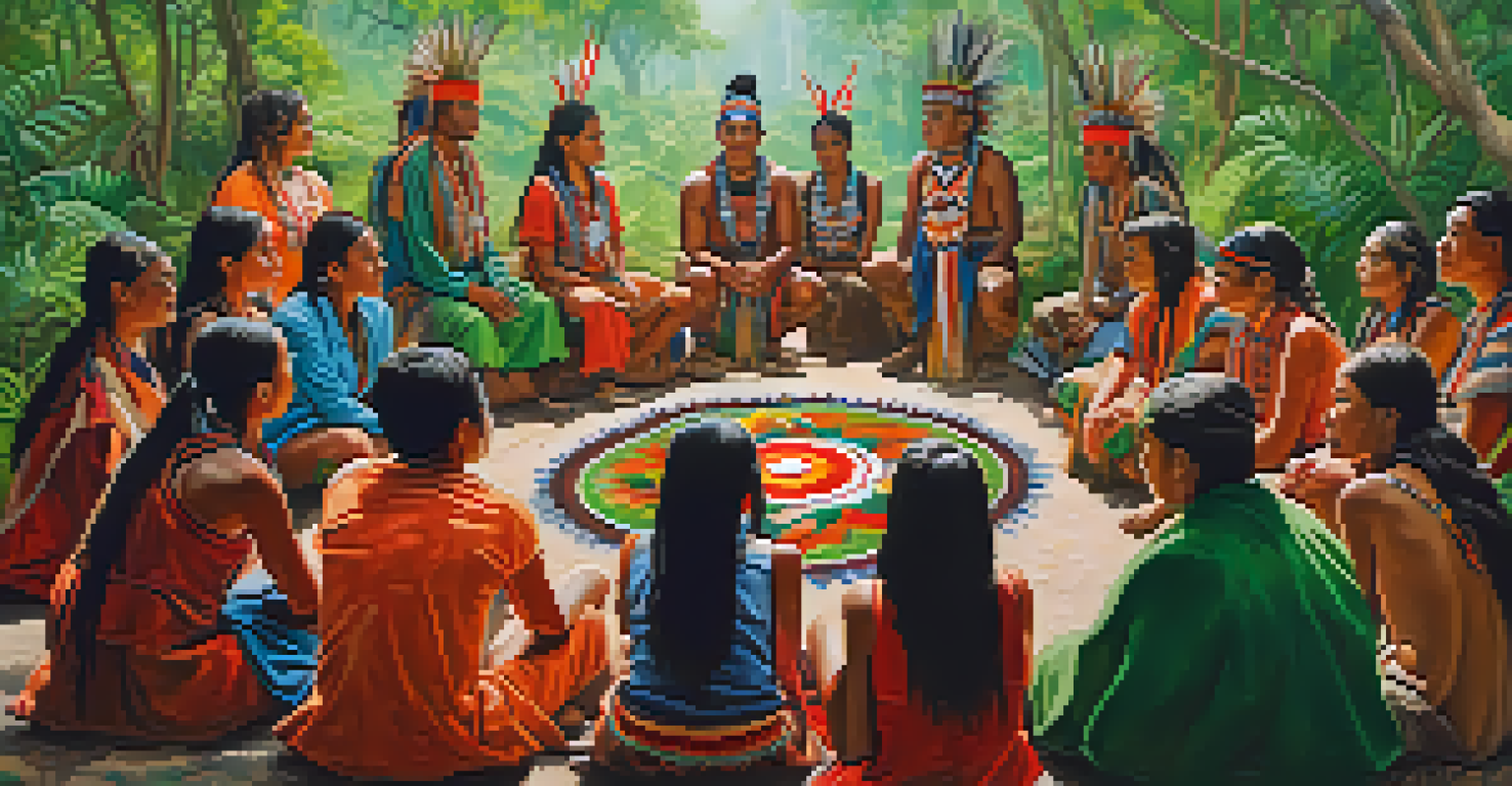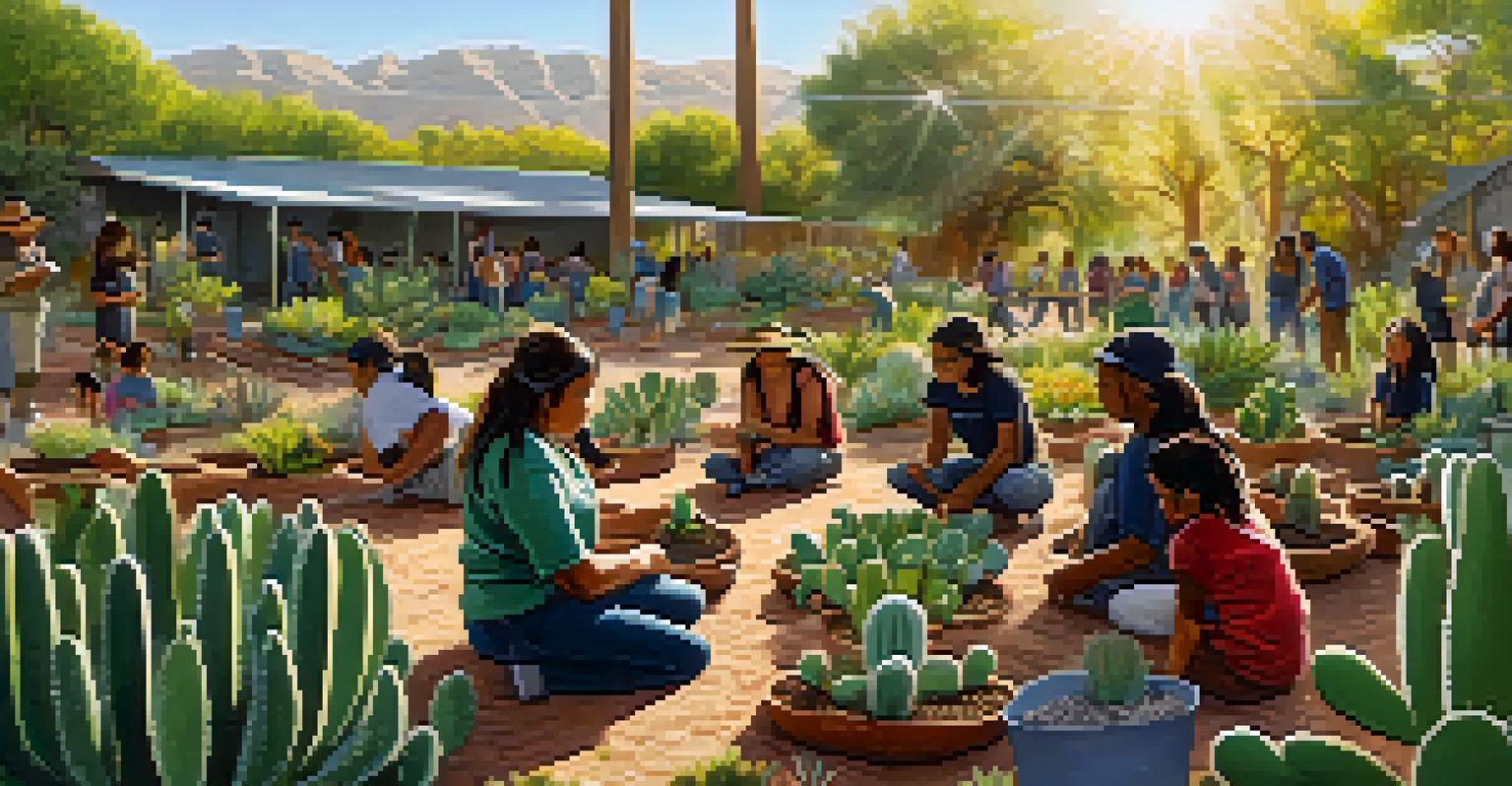Restorative Practices for Peyote Population Recovery

Understanding Peyote's Cultural Significance
Peyote, a small cactus native to North America, holds profound cultural importance for various Indigenous communities, particularly in Mexico and the United States. For these communities, Peyote is not just a plant; it is a sacred medicine used in spiritual ceremonies and healing practices. Understanding this cultural significance is crucial for any restorative efforts, as it encompasses not only ecological factors but also social and spiritual dimensions.
Indigenous knowledge is crucial to the conservation of biodiversity, as it provides insights that scientific methods alone cannot capture.
The ritualistic use of Peyote connects individuals to their heritage and fosters community bonds. This deep-rooted connection suggests that any recovery approach must respect and incorporate Indigenous knowledge and practices. By recognizing this cultural context, we can create more effective strategies that align with the values of the communities that rely on Peyote.
Moreover, the declining populations of Peyote due to overharvesting and habitat loss have raised concerns about the sustainability of this vital resource. As we explore restorative practices, it's essential to prioritize cultural sensitivity and collaboration with Indigenous peoples, ensuring that their voices drive conservation efforts.
Assessing the Current State of Peyote Populations
To effectively restore Peyote populations, we first need a comprehensive understanding of their current state. This involves conducting ecological assessments that evaluate the health and distribution of Peyote plants across their native habitats. Such assessments can reveal critical insights into the factors contributing to their decline, including climate change, land development, and illegal harvesting.

Scientific studies have shown that Peyote populations have faced significant pressures over the years, leading to a dramatic reduction in their numbers. Engaging with local ecologists and Indigenous knowledge keepers can enhance data collection efforts, ensuring that both scientific and traditional ecological knowledge inform our understanding of these populations. This multidisciplinary approach is vital in forming a holistic view.
Cultural Importance of Peyote
Peyote serves as a sacred medicine and cultural touchstone for Indigenous communities, emphasizing the need for culturally sensitive conservation efforts.
Additionally, monitoring these populations over time is crucial. By establishing a baseline and tracking changes, we can gauge the effectiveness of implemented restorative practices and make necessary adjustments. Continuous assessment not only informs recovery strategies but also fosters a sense of shared responsibility among stakeholders.
Implementing Sustainable Harvesting Practices
One of the key challenges in restoring Peyote populations lies in the harvesting practices employed by both Indigenous and non-Indigenous individuals. Promoting sustainable harvesting methods can help balance the cultural practices of Indigenous communities with conservation needs. This may involve setting guidelines that limit the amount of Peyote harvested at any given time or encouraging the cultivation of Peyote in controlled environments.
The health of our ecosystems is directly connected to the health of our cultures; as the plants and animals decline, so do the cultures that depend on them.
Education plays a significant role in this process. Workshops and seminars can be organized to teach both Indigenous community members and the general public about sustainable practices and the importance of protecting Peyote habitats. By raising awareness about the ecological impacts of overharvesting, we can foster a culture of sustainability that respects both tradition and conservation.
Moreover, the involvement of Indigenous communities in crafting these sustainable practices is paramount. Their traditional ecological knowledge can inform guidelines that are not only effective but also culturally relevant. This collaborative approach not only empowers communities but also enhances the credibility of conservation efforts.
Restoration through Cultivation Initiatives
Cultivation initiatives present a promising avenue for restoring Peyote populations while respecting Indigenous cultural practices. By establishing community gardens or greenhouses, we can provide a sustainable source of Peyote without further depleting wild populations. These initiatives can serve as a model for integrating conservation with cultural heritage, demonstrating how both can coexist.
Involving local communities in cultivation efforts not only helps in recovery but also strengthens community ties. Participants can learn about the plant's growth requirements, care techniques, and traditional uses, all while engaging in meaningful work that benefits their community. This hands-on approach fosters a deeper appreciation for the plant and its significance.
Sustainable Harvesting Practices
Implementing sustainable harvesting methods is essential for balancing Indigenous cultural practices with the conservation of Peyote populations.
Furthermore, successful cultivation initiatives can lead to the development of educational resources and programs aimed at teaching both community members and outsiders about Peyote. By sharing knowledge about sustainable cultivation, we can inspire a broader movement focused on the preservation of this sacred plant and its cultural importance.
Partnerships for Effective Restoration Efforts
Collaboration is essential in the quest to restore Peyote populations effectively. Building partnerships between Indigenous communities, conservation organizations, and government agencies can create a united front for recovery efforts. Each stakeholder brings unique perspectives and resources that can enhance restoration strategies, making them more comprehensive and effective.
For instance, Indigenous communities can provide invaluable traditional knowledge about Peyote and its habitat, while conservation organizations can offer scientific expertise and funding. Together, these groups can design and implement restoration projects that are culturally relevant, scientifically sound, and impactful. Establishing these partnerships is not just about resource sharing; it’s about fostering mutual respect and understanding.
Moreover, involving academic institutions in research and restoration projects can further enrich these partnerships. Universities can conduct studies that inform best practices and provide valuable data, while also training the next generation of conservationists to appreciate and integrate cultural considerations into their work. Such collaborations are instrumental in creating a framework for sustainable restoration.
Monitoring and Adapting Restoration Strategies
Once restoration efforts are underway, ongoing monitoring is crucial to assess their effectiveness. By regularly evaluating the health and growth of Peyote populations, we can identify what strategies are working and where adjustments are needed. This adaptive management approach allows for flexibility and responsiveness in conservation efforts, ensuring they remain relevant and effective over time.
Utilizing both scientific methods and traditional ecological knowledge in monitoring can provide a well-rounded perspective on the success of restoration initiatives. Indigenous community members can offer insights that may not be captured by scientific metrics alone, such as changes in the cultural practices surrounding Peyote use. This holistic perspective enriches our understanding of the plant's recovery.
Collaboration for Restoration Success
Building partnerships among Indigenous communities, conservation organizations, and government agencies is vital for effective Peyote restoration strategies.
Additionally, creating feedback loops where community members can share their observations and experiences can strengthen the monitoring process. This participatory approach not only empowers individuals but also fosters a sense of ownership over restoration efforts, encouraging continued engagement and commitment to conserving Peyote populations.
The Future of Peyote and Indigenous Practices
Looking ahead, the future of Peyote populations and their cultural significance hinges on our collective efforts to implement restorative practices. As awareness of the plant's plight grows, so too does the opportunity for innovative solutions that respect both ecological and cultural needs. By fostering dialogue among stakeholders, we can create a vision that honors the sacred nature of Peyote while promoting its sustainability.
Furthermore, integrating modern conservation techniques with traditional practices can lead to effective strategies that benefit both the land and the communities that rely on it. This fusion of old and new can inspire a renewed commitment to conservation efforts, emphasizing the importance of preserving not just the plant but also the traditions and identities tied to it.

Ultimately, the restoration of Peyote populations is not just an environmental issue; it's a cultural imperative. By prioritizing collaborative efforts and respecting the voices of Indigenous communities, we can work towards a future where Peyote thrives in its natural habitat, continuing to serve as a vital element of cultural identity and spiritual practice.